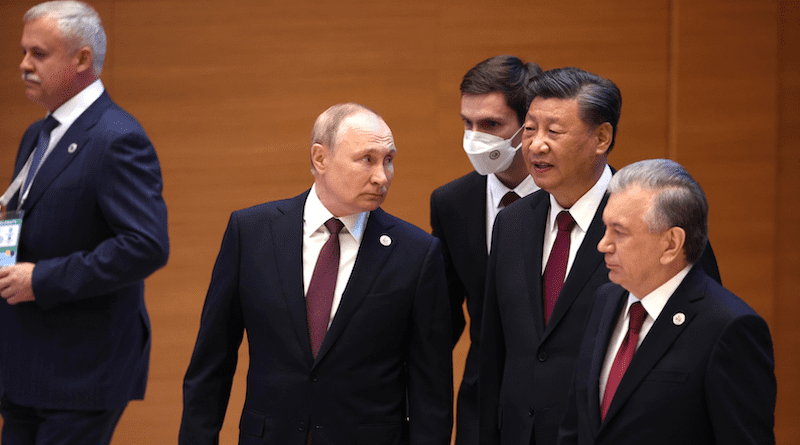Limits And Challenges To China-Russia Cooperation In Eurasia – OpEd
By Saba Kiran
For a number of years, China and Russia have worked together in the Eurasian area, concentrating on a variety of economic, political, and strategic challenges. In reaction to a changed geopolitical environment in which both nations have come under greater pressure from the United States and its allies, the two nations have sought deeper connections. This research will examine the several areas where China and Russia cooperate in Eurasia, its limits and challenges.
China-Russia ties in Eurasia have placed a strong emphasis on economic cooperation. The construction of infrastructure has been a particular area of attention as the two nations have worked to improve their trade and investment connections. The Belt and Road Initiative (BRI), China’s ambitious ambition to construct a network of infrastructure projects across Eurasia, including railways, roadways, and ports, is one of the leading initiatives in this respect.
Russia’s participation in this endeavour has been noteworthy because of the crucial role it plays in making travel between China and Europe more convenient. The two countries have collaborated on a number of key infrastructure projects, some examples of which are the China-Kazakhstan-Russia Crude Oil Pipeline, the Moscow-Kazan High-Speed Rail, and the China-Europe Land-Sea Express Route. As a direct consequence of these activities, there has been a growth in the volume of commerce and investment that takes place not just between China and Russia but also between China and the other countries in the region.
China and Russia have worked together on a variety of political issues affecting Eurasia, including those listed below. Both countries have been open in their opposition to what they see to be efforts by the United States to disrupt the area, most notably by providing assistance to pro-Western political formations and urging the change of government.
China and Russia have worked closely together in order to advance a multipolar global order. This is an order in which no one country or group of states dominates the political and economic landscape of the globe. In addition, they have fought against what they see to be attempts by the United States to surround and isolate their individual states, notably via the deployment of military troops in the region.
Strategic cooperation has been given a high emphasis in China and Russia’s relationship in Eurasia, which has also put a high value on the partnership. Both countries have a vested interest in ensuring that peace and security are maintained across the area because of the continuing crises in Afghanistan and Syria.
Both China and Russia have been very active participants in the fight against terrorism, participating in joint military exercises and sharing intelligence with one another. They have worked together to advocate for political dialogue between the government of Syria and opposition groups in an effort to bring an end to the crisis in the nation. While China and Russia’s cooperation in Eurasia has increased recently, there are still a number of restrictions and challenges that could hinder their alliance. Several of these difficulties include:
There are restrictions on how far China and Russia may collaborate in this sector, despite the fact that both countries have sought tighter economic relations in Eurasia. While China is more interested in exporting manufactured goods to Russia and other nations in the region, Russia is more interested in exporting its natural resources, such as oil and gas, to China. The breadth and depth of their economic collaboration may be constrained by these conflicting economic interests.
Both China and Russia consider Central Asia to be strategically significant and have worked to increase their influence there. Competition has arisen between the two nations as a result, especially in nations like Kazakhstan and Uzbekistan, which are significant allies for both China and Russia. The possibility for broader collaboration in Central Asia may be constrained by the rivalry between the two nations.
Because China and Russia have different political systems, their alliance may face difficulties. Russia has a more decentralised political system with more political plurality than China, which is a one-party state with a highly centralised political structure. Concerns about governance and human rights might arise between the two nations as a result of these discrepancies.
The importance of the Arctic area is rising as a result of its riches and advantageous position. Russia and China have also shown interest in the area, which may result in rivalry between the two nations. While China has been stepping up its economic and scientific endeavours in the Arctic, Russia has a significant presence there and has been developing its military capabilities there. The possibility of regional collaboration may be constrained by this rivalry.
While China and Russia’s cooperation in Eurasia has increased recently, there are still boundaries and difficulties in their relationship. Competition in the Arctic, conflict in Central Asia, conflict between political systems, and disagreements in economic interests are only a few of the obstacles that may prevent their collaboration. Nevertheless, it is obvious that China and Russia will remain significant players in Eurasia despite these difficulties, and their collaboration will have a significant impact on both the region and the global geopolitical environment.
Ms Saba Kiran is an MS graduate of the Department of Aerospace and Strategic Studies at Air University, Islamabad. She has a background in political science and takes an academic interest in ethnopolitical conflicts, national security, strategic stability, and social conflict analysis.

